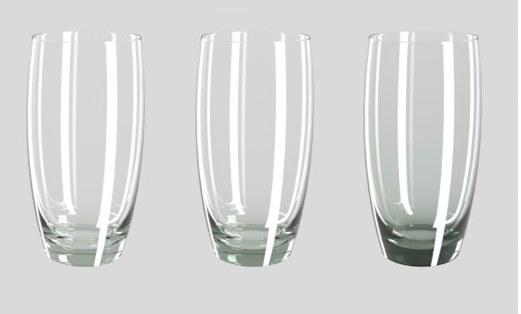Transparency
 The Transparency consists of two components, the refraction and the reflection. Both properties can be controlled via a Blurriness and Roughness effect. On the left is a glass material with 0% Blurriness effect in the refraction and 0% Roughness in the transparency’s Fresnel reflection. At the center is the same material with increase Blurriness for the refraction. The glass now looks milky but still has a perfectly sharp Fresnel reflection on its surface. On the right side the reflection was rendered with an increased Roughness value and the refraction does not use a Blurriness effect. The surface appears rough and dull.
The Transparency consists of two components, the refraction and the reflection. Both properties can be controlled via a Blurriness and Roughness effect. On the left is a glass material with 0% Blurriness effect in the refraction and 0% Roughness in the transparency’s Fresnel reflection. At the center is the same material with increase Blurriness for the refraction. The glass now looks milky but still has a perfectly sharp Fresnel reflection on its surface. On the right side the reflection was rendered with an increased Roughness value and the refraction does not use a Blurriness effect. The surface appears rough and dull. Coloring in transparent media can be achieved using the Absorption setting. The series of images shows a greenish absorption color whose effect on the glass material was amplified by decreasing Absorption Distance values.
Coloring in transparent media can be achieved using the Absorption setting. The series of images shows a greenish absorption color whose effect on the glass material was amplified by decreasing Absorption Distance values.This material property can be used to create transparent or refractive materials such as glass or water. For completely transparent materials, the Diffuse, Reflection, Coating and Emission settings will not be made available. Transparency can, however, also be used to create reflections.
This setting is used to multiply the material’s transparency with the selected color. Dark or deeply saturated colors will lead to correspondingly less transparency. The brightness of the selected color can therefore be used to reduce the channel’s opacity, comparable to the Opacity or Intensity settings. The Absorption setting is better suited to color fluids or glass since it has no effect on the transparency.
This is a list of common refraction indices of transparent materials such as glass or water.
If the material you want to simulate is not included in the Presets list, a custom refraction value can be entered here. The refraction index also affects the intensity of the additionally calculated reflection. Larger values amplify the reflection and darken the transparency correspondingly. Furthermore, the distortion increases in the transparency. A refraction index of 1.0 reflects that of air at room temperature and does not create any refraction or reflection. Combined with a slightly darkened transparent color and a reflection, this can nevertheless be used to simulate thin foil or a thin pane of glass.
This setting is used to define the dispersion within the transparency. Increasing values will blur the visible objects behind the transparency correspondingly more. A stronger Blurriness effect will as a rule increase render times accordingly.
Fresnel Reflectivity [0..100%]
The defined Refraction Index is also used for the calculation of reflections on a transparent surface. Areas viewed perpendicularly will automatically reflect less than areas viewed at flatter angles. The Fresnel Reflectivity can be used to adjust the intensity of the reflections independent of the transparency.
This setting can be used to define the dispersion of the Fresnel Reflectivity on the transparency and thereby simulates a matte or rough surface. Increasing values can also lead to longer render times.
As soon as a reflection sample hits a solid object when glass is rendered, two slightly different reflections can be calculated – one that results when the sample enters the glass and one when it exits the glass. Visually, the single reflection can only look good on the front side of the surface, even if this is not physically correct. The option should then be disabled.
This setting defines the color with which the light that penetrates a material should be colored. This can, for example, be used to simulate colored fluids or glasses without darker colors causing the transparency’s intensity to be weakened.
This setting defines the distance at which the ray of light in the material will assume the Absorption color completely. If the ray of light lies farther away in the material, the light’s color will strengthen additionally.